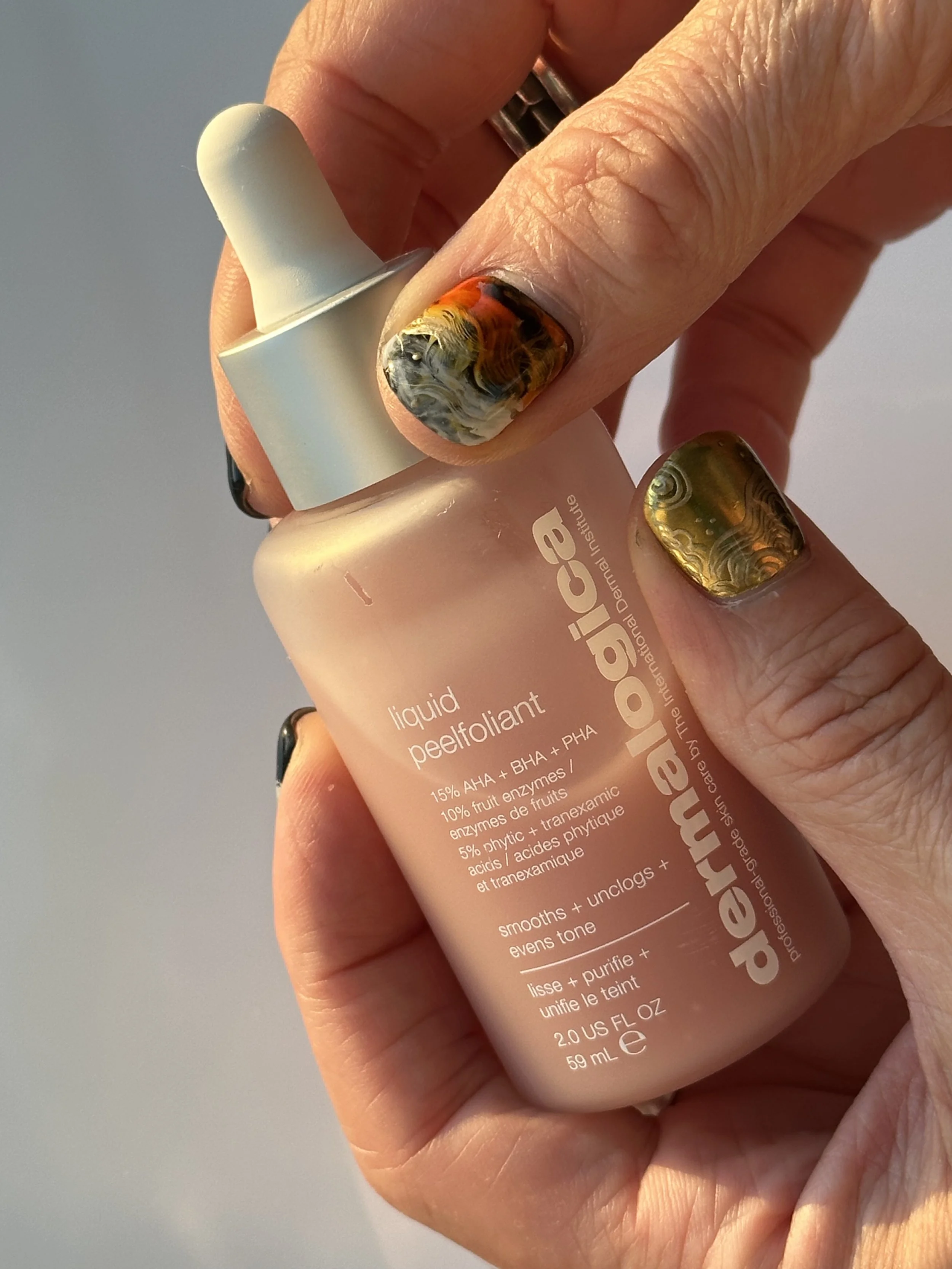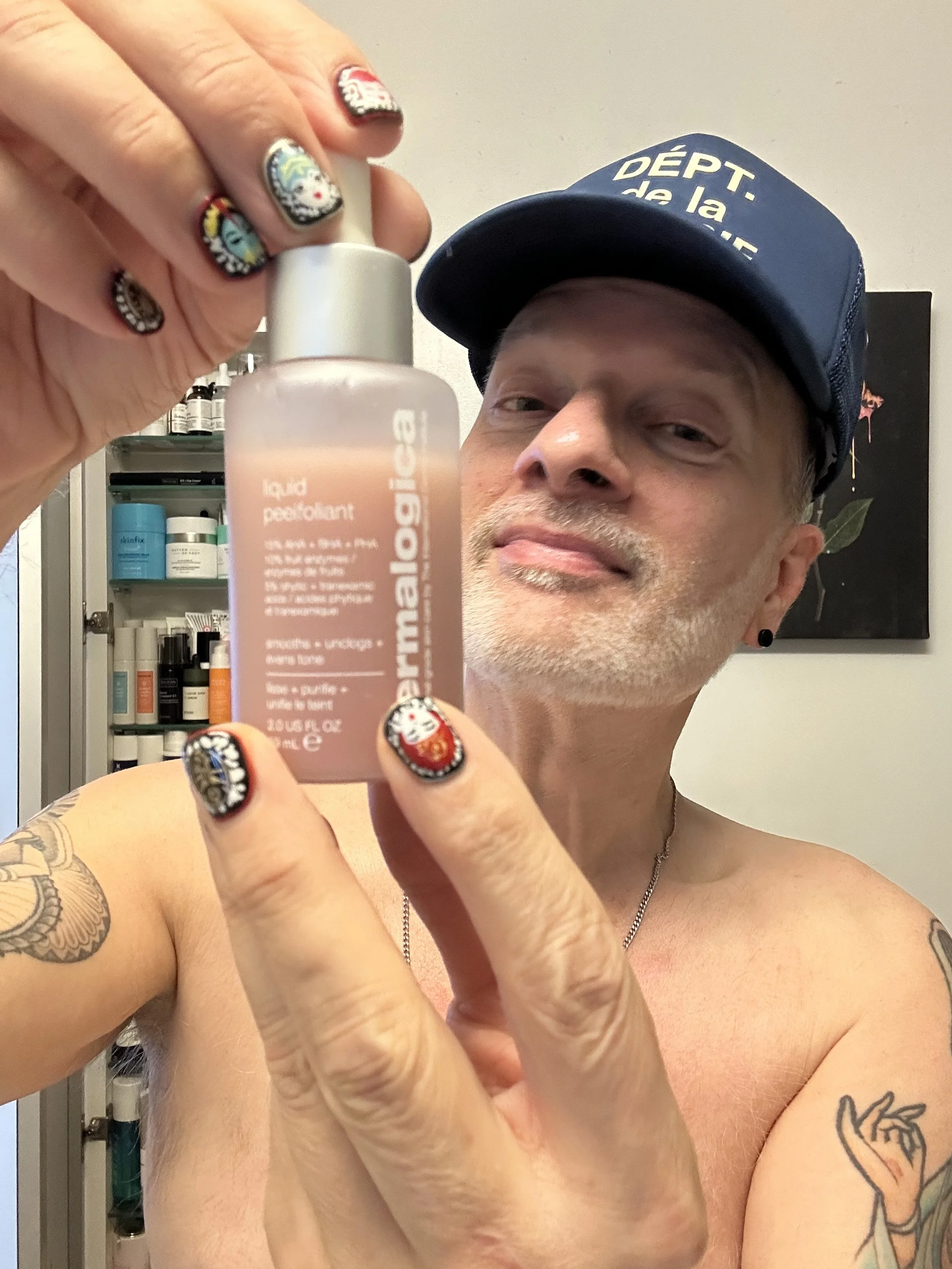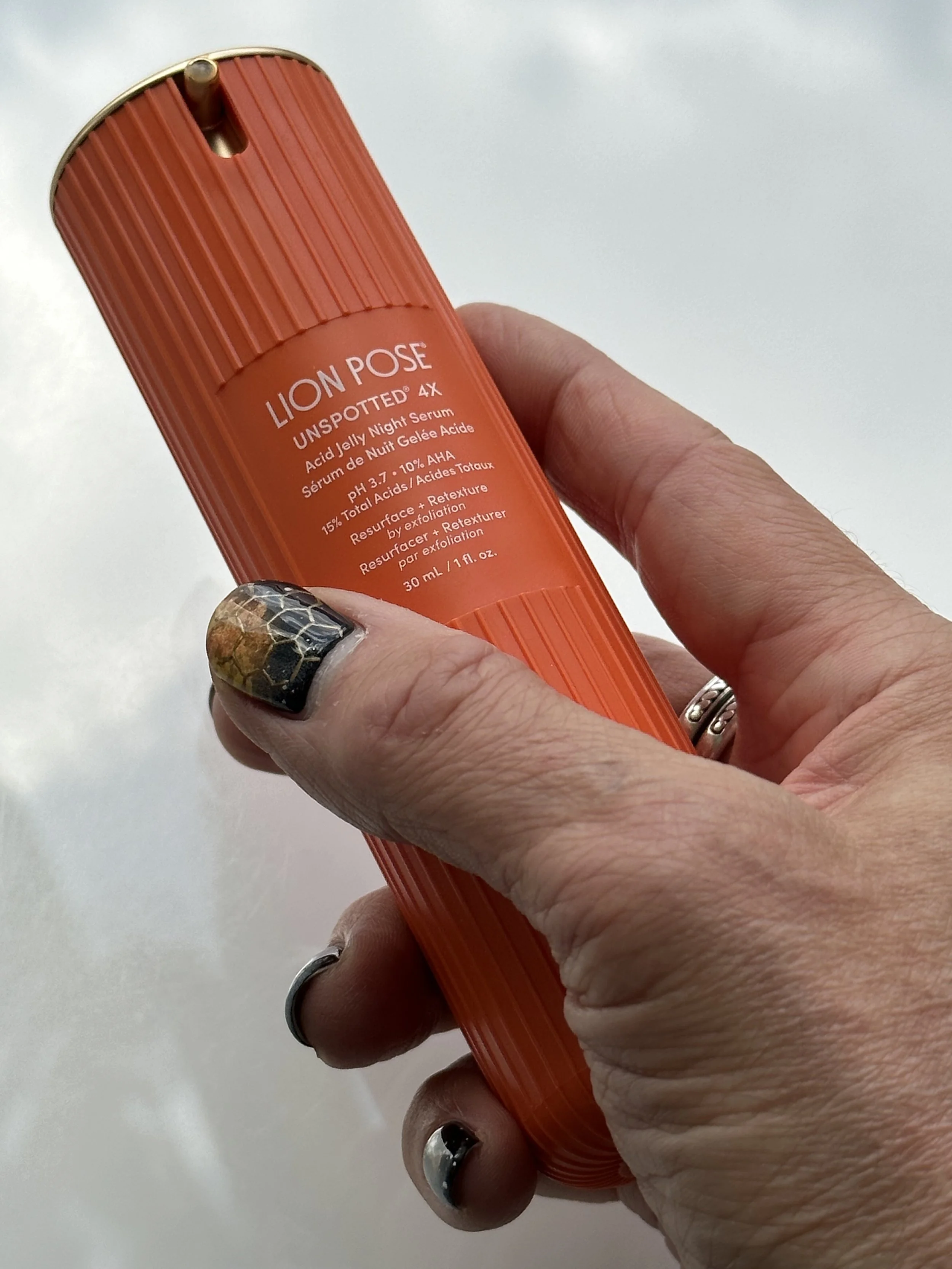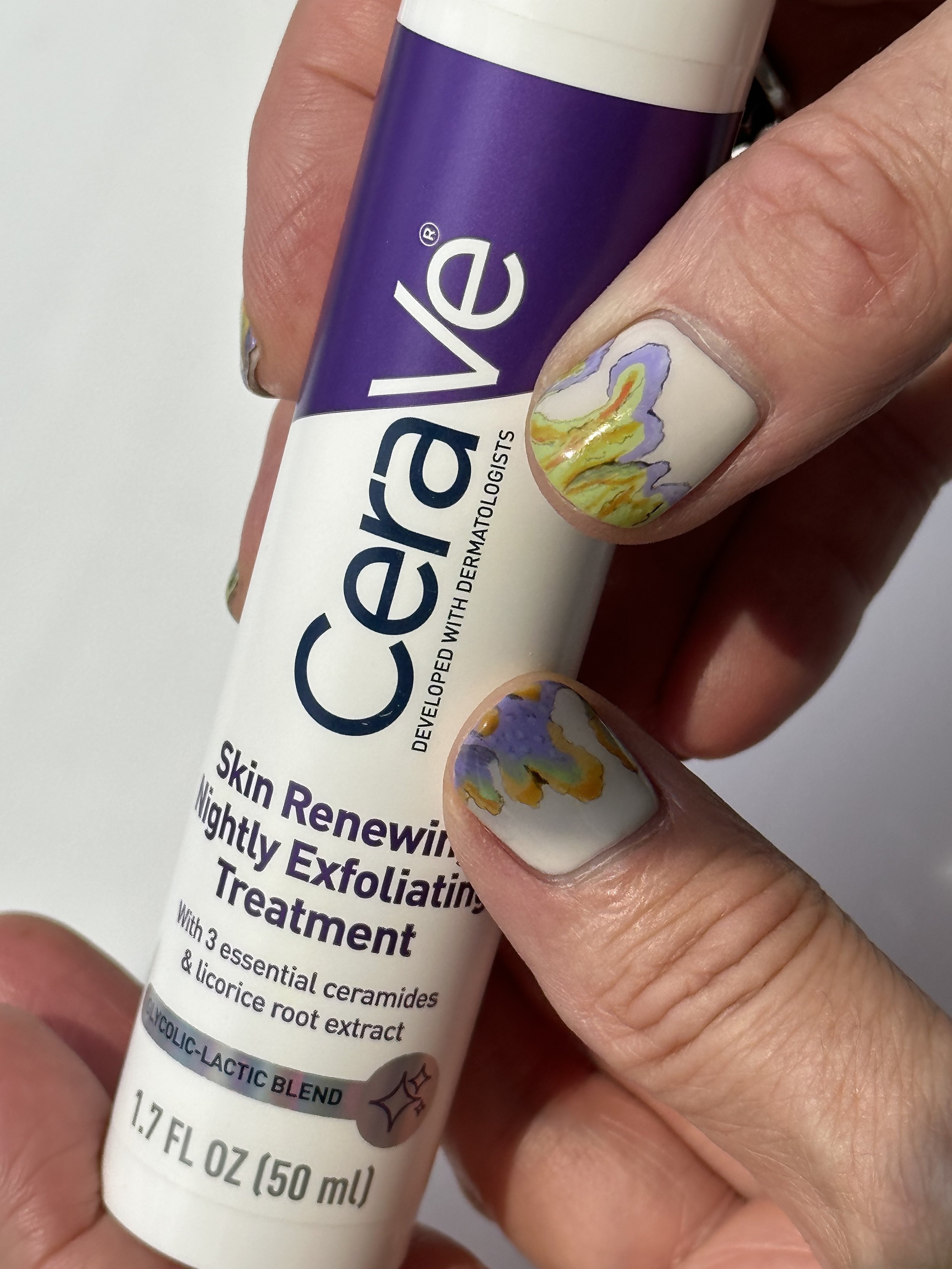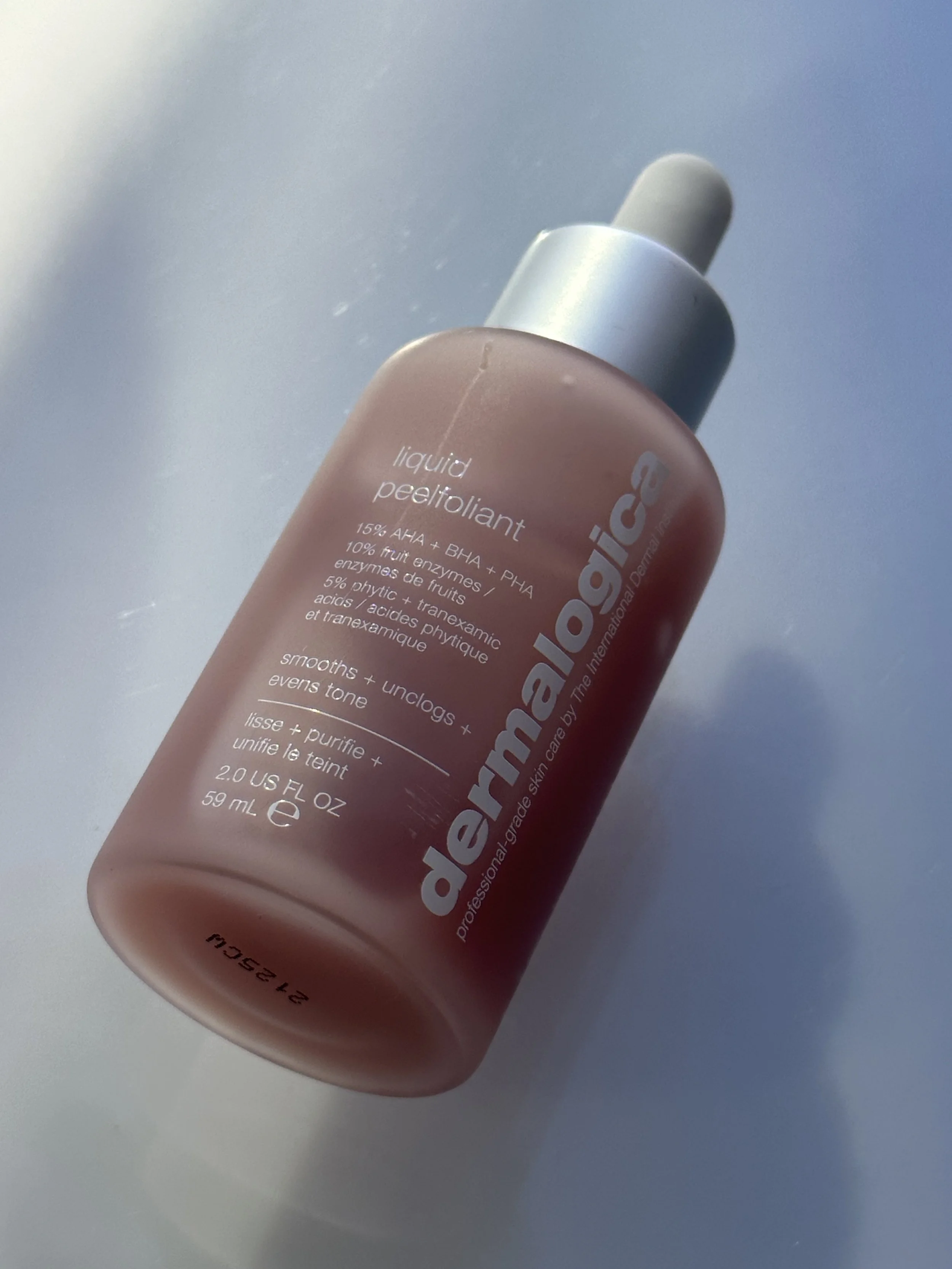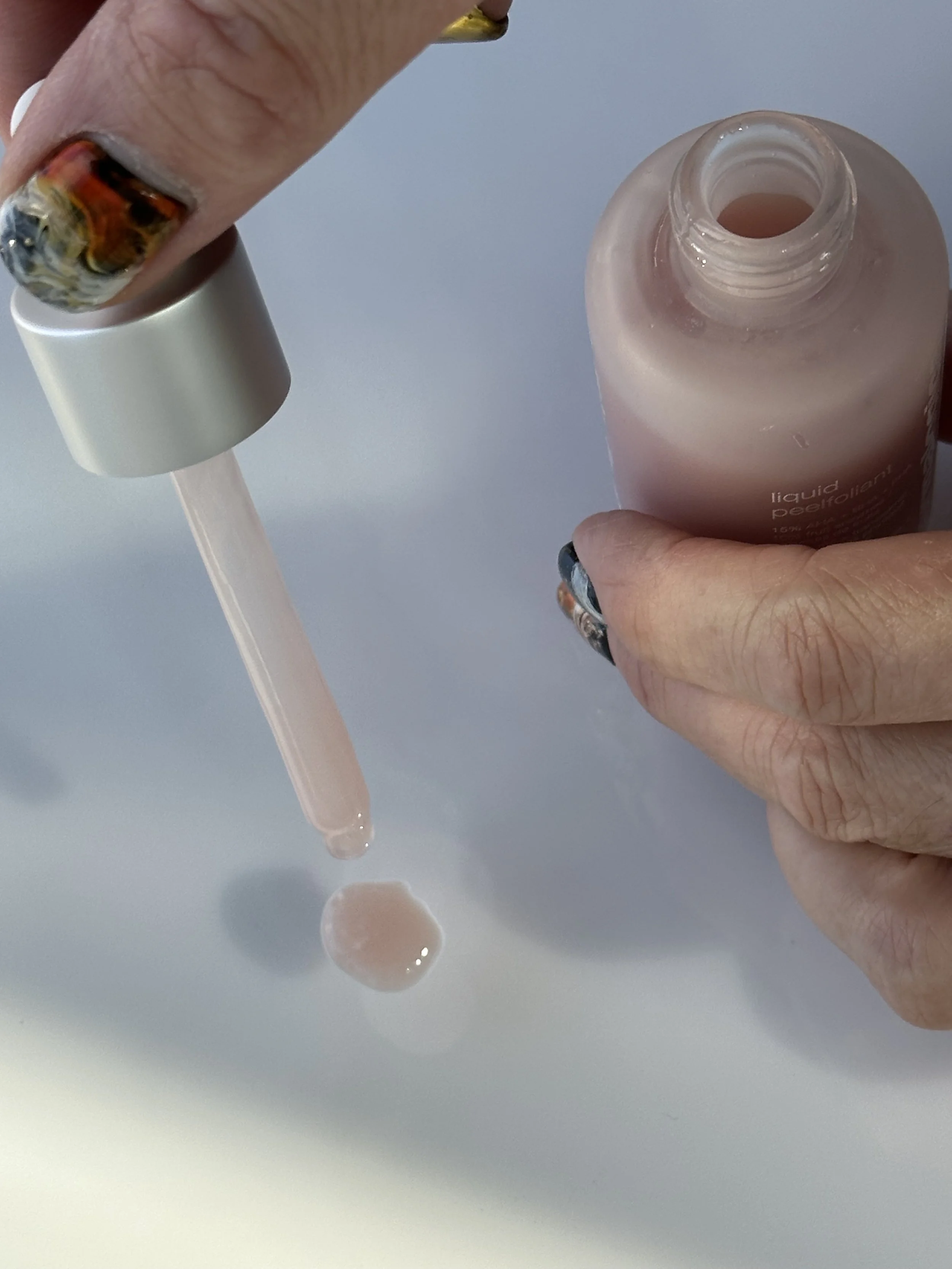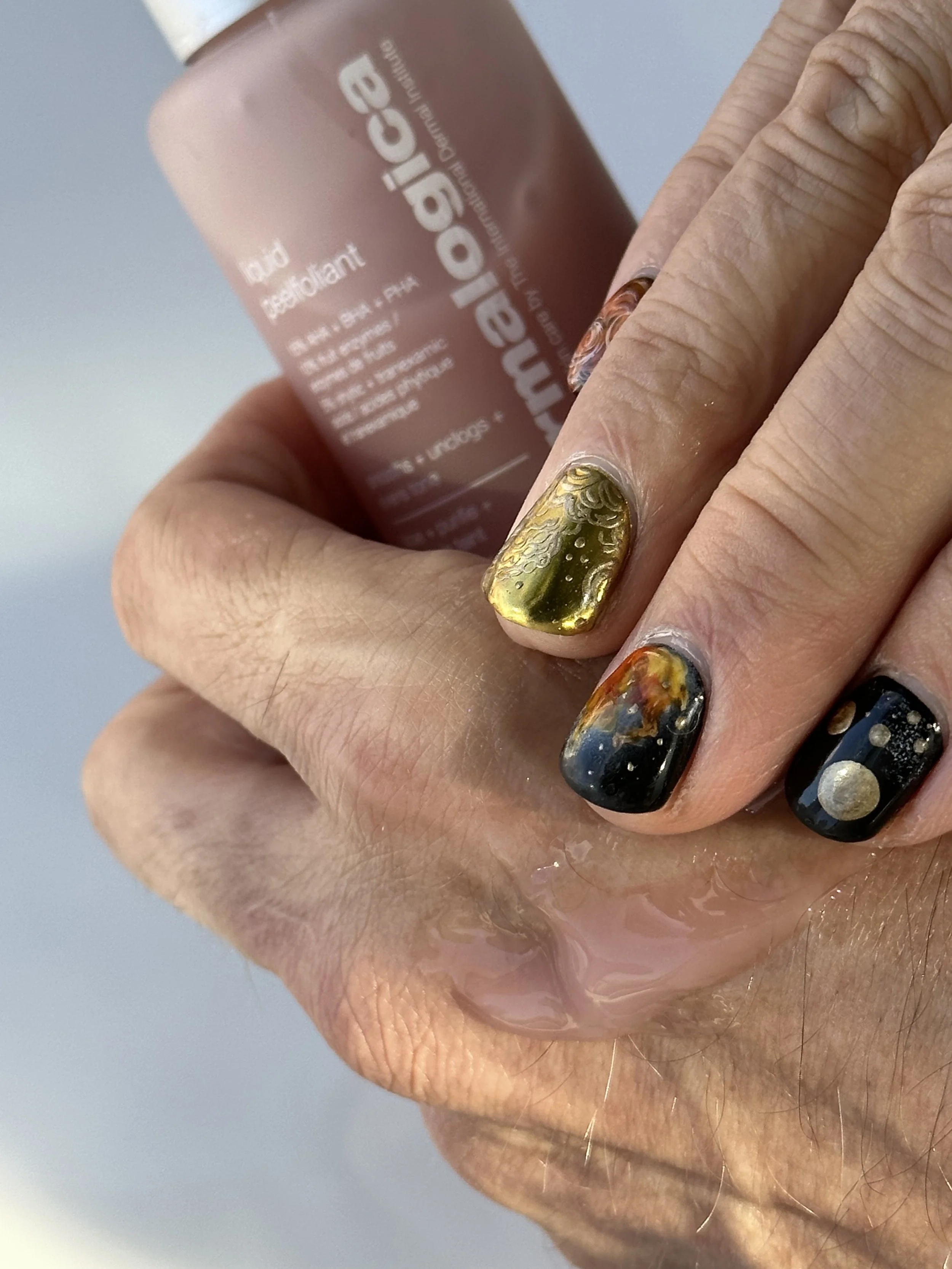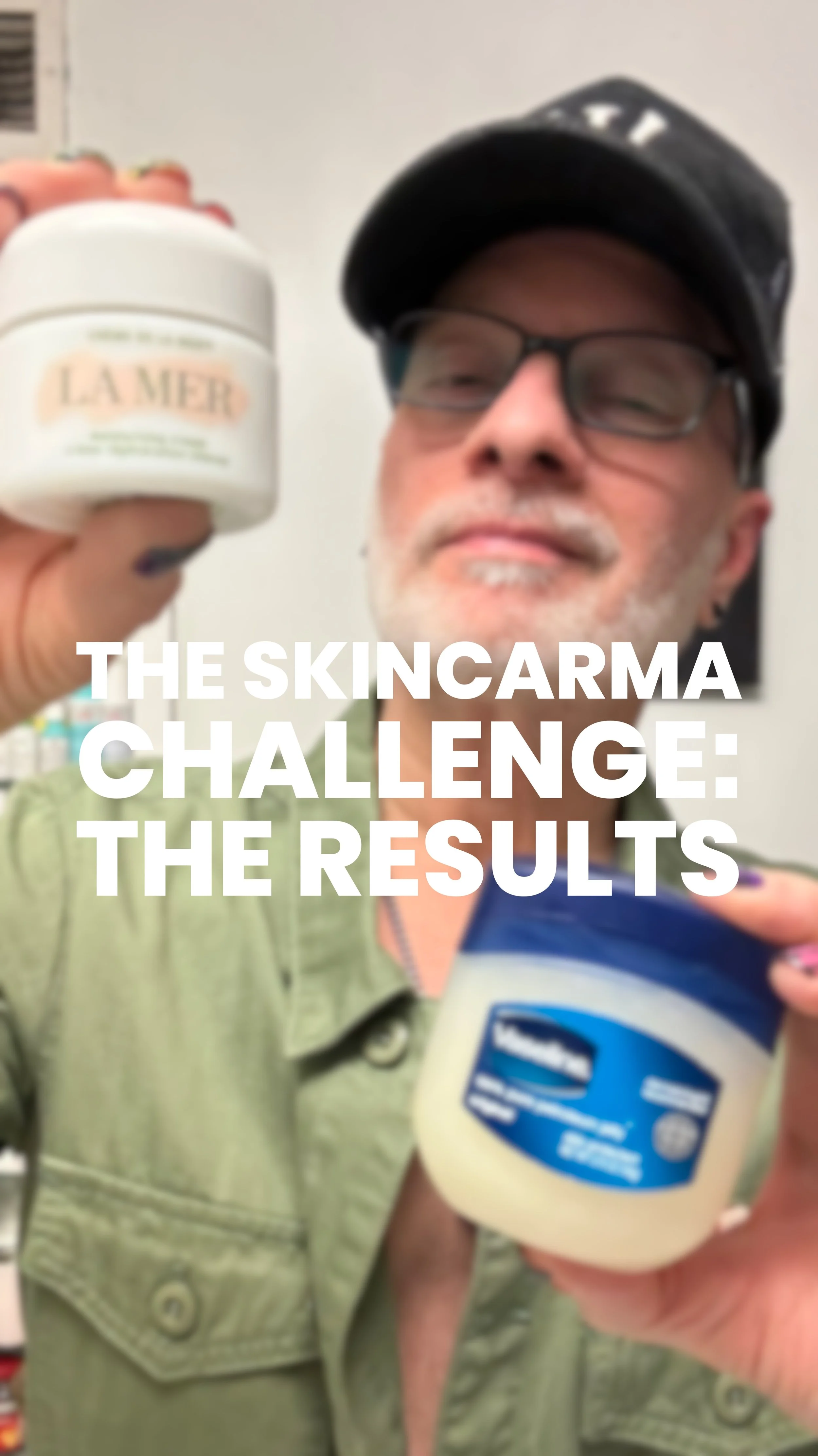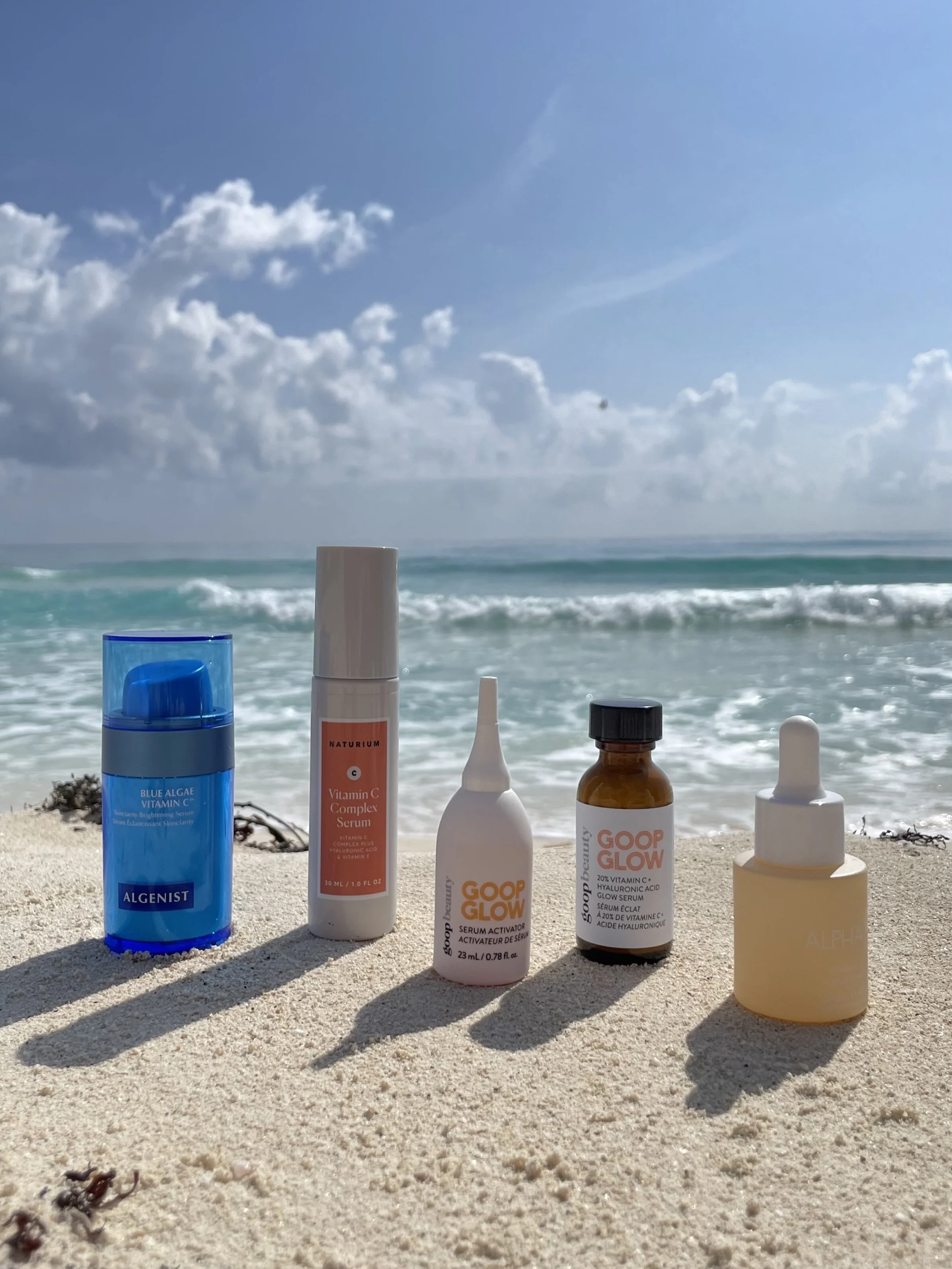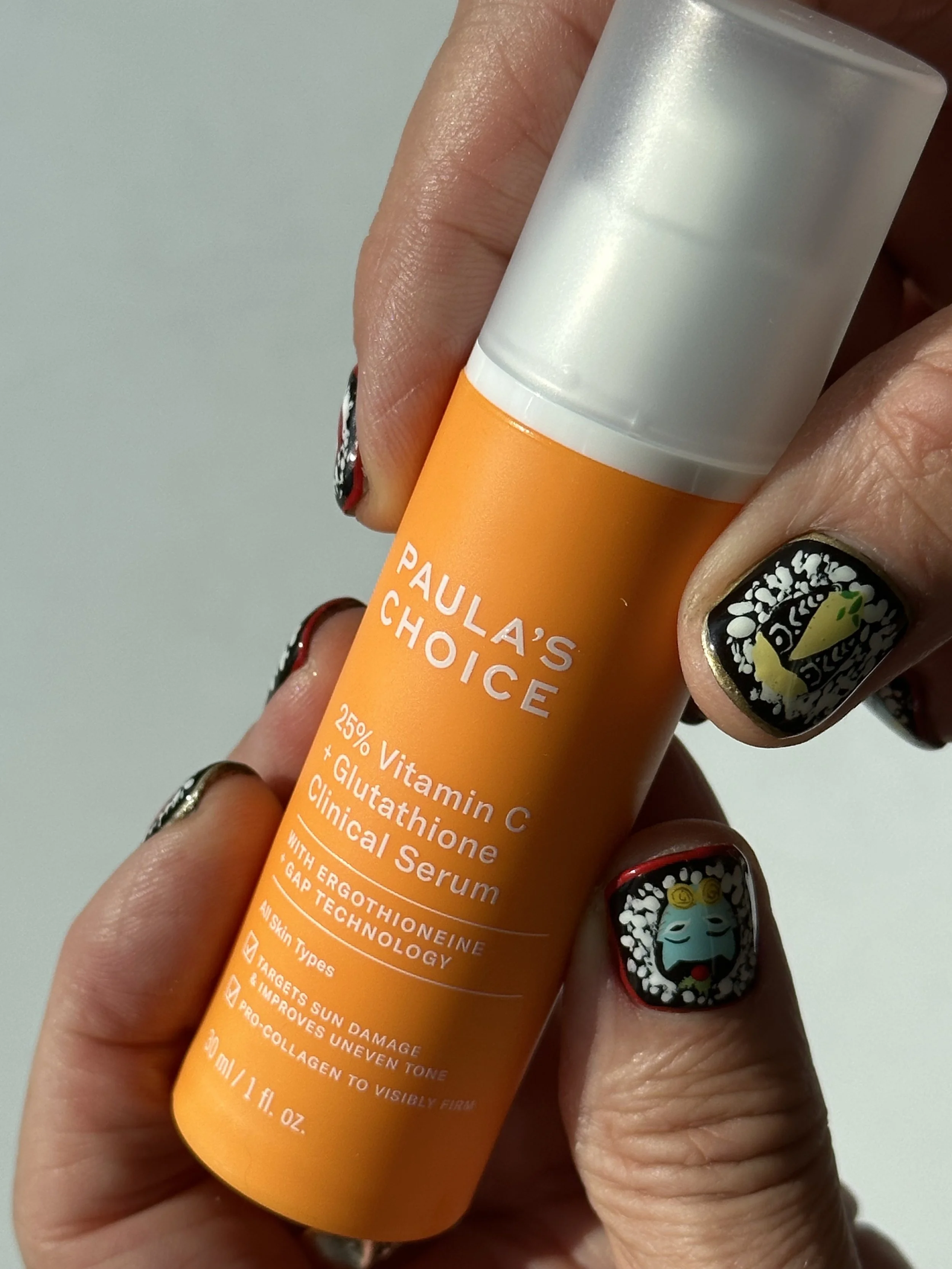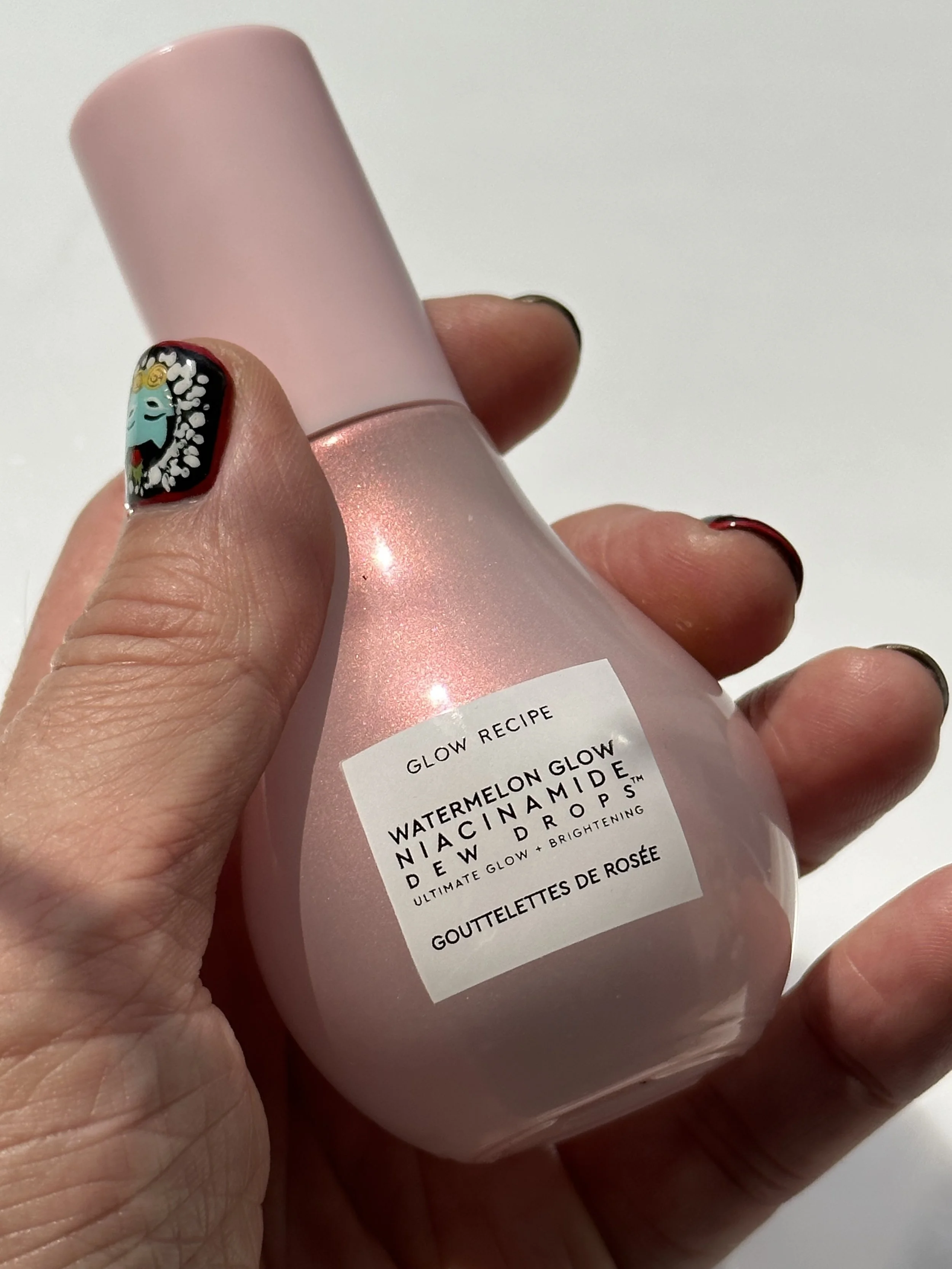PRODUCT REVIEW: DERMALOGICA LIQUID PEELFOLIANT EXFOLIATOR WITH AHA, BHA AND PHA - What is the best percentage of glycolic acid? Is 10% glycolic acid too strong? What does PHA do for skin?
DERMALOGICA LIQUID PEELFOLIANT
I get antsy when it comes to really strong exfoliating treatments with Glycolic Acid. Like many people, it’s not my intent to overdo it, but sometimes things go left.
And, just like the best Retinol face creams, you really don’t know what’s gonna happen with a Glycolic Acid serum until you try it!
I remember a time when there were no Glycolic Acid exfoliating serums available over the counter. You couldn’t just do it yourself. If you wanted an acid peel, you needed to see a professional to get it done safely. And it could still be over the top!
My first time getting a Glycolic Acid peeling treatment at a high-end spa was also my last. I had made the mistake of making an appointment for a hot, sunny Saturday afternoon in August. With all our concrete, NYC is hot, humid and unforgiving in summer. My face was super inflamed and the last thing I needed was to walk out of the spa into the blazing sun beating down onto the City streets. I tried to stay in the shade, walking alongside the buildings like some sort of weirdo. It was nuts!
That experience left me emotionally scarred and I always approach a new exfoliating acid treatment with that at the front of my mind. Sure, like millions of skincare addicts, I’ve played with The Ordinary AHA 30% + BHA 2% Peeling Solution. Guess what! It always terrifies me!
Tthe new Dermalogica Liquid Peelfoliant contains 10% Glycolic Acid blended with several other acids and enzymes. It’s not nearly as terrifying, but it sure is potent. More on my experience with over the last several weeks just below.
THE BEST NIACINAMIDE SERUMS
Thirty percent. Ten percent. You might be wondering what percentage of Glycolic Acid is the most effective. The answer really depends on what you’re trying to achieve.
Skincare brand marketers love to play the percentage game with potent actives like Vitamin C, Retinol and, yes, Glycolic Acid. They believe it’s easier to drive product appeal among consumers if there’s a higher percentage of an active that distinguishes itself from competitors. To me, it’s the game of lazy marketers.
The truth is, higher isn’t always better. What’s most important is what your skin concerns are, what your skin can tolerate, and how well a product is formulated. (This is where a formula’s pH makes a big difference.) Very often, you’ll get the same results from a lower concentration of an active.
Vitamin C is the classic example. Do you need a 35% Vitamin C serum like the Allies of Skin 35% Vitamin C Perfecting Serum to see a brighter complexion and a boost in collagen production? I sure don’t. And I don’t think anyone does. That Allies of Skin Vitamin C serum is one of probably a dozen I have on hand and I never use it. A 10% or 15% Vitamin C serum twice a day is enough for me – and enough for most people.
What percentage of Glycolic Acid is most effective?
A study published in the Journal of Cosmetic Dermatology compared the efficacy of different concentrations of Glycolic Acid for skin rejuvenation. The study found that a concentration of 10% Glycolic Acid was effective in improving skin texture, reducing the appearance of fine lines and wrinkles, and enhancing surface radiance.
Source: Journal of Cosmetic Dermatology
WHY IS THIS PEPTIDE SERUM SO DELISH?
The same goes for The Ordinary’s iconic AHA 30% + BHA 2% Peeling Solution. Yes, it’s effective AF. But I believe its true appeal is the crazy 30% concentration of alpha hydroxy acids in the formula. Yikes! That’s the kind of concentration you expect to get in a peeling treatment at a dermatologist’s office. I use it maybe twice a year.
I’m not a big fan of shocking my skin barrier to achieve instant results or to optimize my skin health. When it comes to a Glycolic Acid exfoliating serum or stronger peeling treatment, slow and gentle is nearly always better.
A few weeks ago, I featured one of the best overnight exfoliating treatments with Glycolic Acid – the new Lion Pose Unspotted 4X Acid Jelly Night Serum. With a 15% concentration of Glycolic Acid, Lactic Acid, Azelaic Acid and Tranexamic Acid, it works while you sleep. It’s strong but it’s not harsh.
As I said in my review of it here, the Lion Pose Unspotted 4X dark spot serum is one of the most innovative (and coolest!) brightening face serums with Glycolic Acid I’ve come across in a while.
PRODUCT REVIEW: LION POSE UNSPOTTED 4X ACID JELLY NIGHT SERUM
As an overnight leave-on treatment, it represents true innovation in a category that is often little more than the same technology spun with savvy marketing that pushes high percentages.
While I saw a brighter complexion the mornings after, I recognize that strong acid treatments like the Unspotted 4X Acid Jelly Night Serum are not well tolerated by sensitive skins. And they can certainly be sensitizing for those who don’t normally experience signs of irritation.
If you have sensitive skin, or are wary of really strong exfoliating treatments, you may want to consider a milder leave-on exfoliating cream like the new CeraVe Skin Renewing Nightly Exfoliating Treatment which I reviewed on the blog here.
With a 5% blend of both Glycolic and Lactic Acids, it’s among the best exfoliating creams with Glycolic Acid for sensitive skin that I’ve come across. It’s exactly what sensitive skin requires.
You won’t get immediate results, but as I said, sometimes “slow and steady wins the race.” I’m a bug fan of it! Again, you can catch my full CeraVe Skin Renewing Nightly Exfoliating Treatment product review here.
PRODUCT REVIEW: CERAVE SKIN RENEWING NIGHTLY EXFOLIATING TREATMENT
Before I get into my detailed Dermalogica Liquid Peelfoliant Exfoliator product review just below, I wanted to explore some of the most frequently asked questions about Glycolic Acid and the other exfoliating acids specific to the formula…
1. What is the best percentage of glycolic acid?
The best concentration of Glycolic Acid for you really depends on what your skin concerns are and what your skin will tolerate. If you’re simply looking to accelerate cell turnover for a brighter, smoother complexion, a 5% concentration is likely enough. If you’re looking to smooth out bumps and a rough skin texture, a more potent Glycolic Acid cream or peeling treatment is the way to go.
Generally, concentrations between 8-10% are considered effective for at-home use, while higher concentrations (up to 70%) are used in professional chemical peels at a spa or through a dermatologist.
A study published in the Journal of Cosmetic Dermatology found that a concentration of 10% Glycolic Acid was effective in improving skin texture, reducing fine lines and wrinkles, and enhancing skin’s radiance. Another study published in the Journal of the American Academy of Dermatology showed that a concentration of 30% Glycolic Acid had a significant improvement in acne severity and overall skin texture.
Sources: Journal of Cosmetic Dermatology: Efficacy of glycolic acid peels in the treatment of melasma; Journal of the American Academy of Dermatology: A randomized controlled trial of 6% dimethylaminoethanol gel and 0.2% glycolic acid for the treatment of photoaging
2. Is 10% glycolic acid too strong?
A 10% concentration of Glycolic Acid is generally considered safe and effective for most people. However, an individual’s skin tolerance and sensitivity can be a determining factor in whether a treatment with 10% Glycolic Acid is too strong. Additionally, the amount of time the product is left on the skin as well as a product’s pH level are important considerations.
The best way to determine if a 10% Glycolic Acid treatment or peel will work for your skin is to go easy at first. I recommend using the product for less than what’s suggested in the packaging directions. Trust me, I’ve written hundreds of packaging directions in my day job as a skincare copywriter!
If 10 minutes is recommended, I will leave it on for 5 minutes the first time. 30 minutes is whittled to 15. Once I have seen how my skin reacts, I adjust from there.
According to a study published in the Journal of Cosmetic Dermatology, a concentration of 10% Glycolic Acid was found to be effective in improving skin texture, reducing fine lines and wrinkles, and enhancing radiance.
Sources: Journal of Cosmetic Dermatology: Efficacy of glycolic acid peels in the treatment of melasma
3. What does PHA do for skin?
PHA, or polyhydroxy acid, is a type of chemical exfoliant that’s become increasingly common in OTC exfoliating treatments. Among the most popular skincare products with polyhydroxy acid are The INKEY List PHA Toner, the Glow Recipe Watermelon Glow PHA + BHA Pore-Tight Toner and Naturium’s PHA Topical Acid 12%.
Among the most common PHAs found in skincare products (you’ll see them in your product INCIs) are Gluconolactone, Lactobionic Acid and Galactose. PHAs offer similar benefits to alpha hydroxy acids (AHAs) like Glycolic Acid and Lactic Acid, but they are far gentler on the skin and better tolerated by sensitive skins.
Similar to more common AHA acids, PHAs exfoliate the skin’s outer layer and promote cell turnover to reveal a brighter, smoother complexion.
One of the main advantages of PHAs is their larger molecular size, which means they penetrate the skin more slowly and are less likely to cause irritation or sensitivity. This is the same reason that the most gentle of the AHAs, Mandelic Acid, is better tolerated by the skin. Their larger molecular weight makes them more suitable for individuals with sensitive skin or those who experience irritation from other types of exfoliants.
PHAs have additional benefits for the skin. They act as humectants like Hyaluronic Acid, attracting and retaining moisture in the skin, helping to improve hydration levels. PHAs also have antioxidant properties, which can help protect the skin against environmental damage.
Sources NIH, National Library of Medicine, PubMed: A polyhydroxy acid skin care regimen provides antiaging effects comparable to an alpha-hydroxyacid regimen; Healthline: Brainy Beauty: What Can PHAs Really Do for Your Skin?
4. Can I use PHA and BHA together?
Generally, you can use PHAs (polyhydroxy acids) and BHAs (beta hydroxy acids) together in your skincare routine. PHAs and BHAs are both types of chemical exfoliants that help to remove dead skin cells, unclog pores, and improve skin texture. But they do have distinct benefits.
PHAs are known for their gentle exfoliating properties and are suitable for individuals with sensitive skin. They have larger molecular sizes compared to BHAs and the more common AHAs like Glycolic and Lactic Acids. Because of this, they penetrate the skin barrier more slowly and are less likely to cause irritation. PHAs also have humectant and antioxidant properties for the skin.
BHAs such as Salicylic Acid are oil-soluble and can penetrate deep into the pores, where they dislodge the hardened sebum that traps bacteria and dirt. This makes BHAs particularly effective for acne-prone and oily skin. While Salicylic Acid is recommended and most often marketed towards those with an oily skin type, all skins can benefits from the acid’s ability to keep pores clear and gently exfoliate the skin surface.
When using PHAs and BHAs together in the same routine, it's important to consider the concentration of acids in each product in order to mitigate against over-exfoliation and sensitizing the skin.
The Glow Recipe Watermelon Glow PHA + BHA Pore-Tight Toner is one of the best skin care products with BHA and PHA together. Catch my review of it on the blog here.
Sources: First Derm: AHA vs BHA vs LHA vs PHA: The Difference between Exfoliating Acids in Skincare; Byrdie: Everything You Need to Know About Polyhydroxy Acid (PHA)
5. Product Review
Dermalogica Liquid Peelfoliant Review
The first thing to know about the new Dermalogica Liquid Peelfoliant exfoliating acid peel is that it’s legit. I’ve come across many similar products over the years and they run the gamut. Some work well – often too well – and others are just duds. Most are not very pleasurable or easy to use.
There is literally nothing I enjoy about the experience of The Ordinary’s AHA 30% + BHA 2% Peeling Solution. It works like skincare tough love!
But Dermalogica’s Liquid Peelfoliant is the whole package. It’s strong, effective, easy to use – and maybe as important, a pleasure to use. That shouldn’t be much of a surprise since Dermalogica is kind of the OG when it comes to exfoliation. The iconic Daily Microfoliant was my first experience with the brand – way back to my days working at Kiehl’s in the mid-2000s.
First introduced in 2001, the Dermalogica Daily Microfoliant is a gentle exfoliating powder that’s activated with water to create a rich, creamy face scrub that helps remove dead surface skin cells to brighten the complexion and improve skin texture. I’d go far as to say it’s a cult favorite skincare product.
But I’m not a fan of physical exfoliation, no matter how gentle. Unless I’m getting a professional microdermabrasion treatment, I almost never use an exfoliating scrub. Anything that has the potential to scratch or tear the skin barrier is not your friend. That includes face scrubs and poorly trained dogs.
The only exfoliation I engage in is chemical. So I was super excited to try Dermalogica’s new Liquid Peelfoliant. But, unlike the brand’s creamy exfoliating powder, it’s not all that gentle – and it isn’t intended to be.
The Liquid Peelfoliant is infused with a cocktail of exfoliating acids and fruit enzymes that the brand says amounts to a 30% active blend. Of course, that brings to mind the AHA 30% + BHA 2% Peeling Solution from The Ordinary. But it’s not nearly as harsh or jarring.
Dermalogica’s 30% concoction is comprised of what the brand says is a 15% blend of AHAs, BHAs and PHAs: Glycolic Acid, Lactic Acid, Salicylic Acid and Gluconolactone. In addition, there’s a 10% fruit acid blend and a 5% concentration of Phytic Acid and Tranexamic Acid – this year’s sexy new skincare ingredient.
CATCH THIS HIGH-POTENCY ACID SERUM IN ACTION
I’ve used the Dermalogica Liquid Peelfoliant multiple times now over the past 6 weeks. Initially, my experience was what I was expecting from an acid peel – a whole lot of redness and tingling.
It’s very much like a serum with a pleasant velvety, gooey texture that is easy to spread over cleansed skin. That first time, I only left it on for about 30 seconds before washing it off entirely. As is my customary practice, I used it for half the recommended time. It was enough. My complexion was red for a few minutes but calmed down well, leaving a fresh, clear and bright complexion.
I tried it again about a week later and this time experienced no irritation or redness. That was also the case in subsequent uses. I really risked it once or twice and left it on for a couple of minutes – three minutes at most. All I’ve seen is an instantly brighter, smoother and refreshed complexion.
I love this peeling treatment. It seems to be so well formulated. And, it’s such a pleasure to use. It’s the kind of product you want before a special event, a photo shoot, or for whenever your complexion is looking lackluster and lifeless. I don’t know if it’s ideal for sensitive skin types but for everyone else, it’s good stuff.
6. Pros & Cons
What I like about it: The Dermalogica Liquid Peelfoliant Exfoliator is one of the best acid peels with Glycolic Acid that I’ve tried. I love its blend of exfoliating acids, fruit enzymes and other skin brighteners, including Tranexamic Acid. For an acid peel, it’s remarkably non-irritating.
What I don’t like about it: It bums me out that the brand put fragrant plant oils in the formula. Bergamot Fruit Oil and Mandarin Orange Peel Oil are known to irritate sensitive skin, something that’s already a concern with a strong acid peel.
Who it’s for: All skin types, except very sensitive skins.
SHOP THE BLOG: Want to try it for yourself? Purchase the Dermalogica Liquid Peelfoliant Exfoliator for $65 here.
The Ingredient List of the Dermalogica Liquid Peelfoliant Exfoliator:
Water/Aqua/Eau, Lactobacillus/Punica Granatum Fruit Ferment Extract, Glycolic Acid,
Aminomethyl Propanol, Phytic Acid, Gluconolactone, Glycerin, Propanediol, Lactic Acid, Salicylic Acid, Tranexamic Acid, Hydroxyacetophenone, Sodium Hyaluronate, Hydrolyzed Gardenia Florida Extract, Zanthoxylum Bungeanum Fruit Extract, Vaccinium Macrocarpon (Cranberry) Fruit Extract, Helianthus Annuus (Sunflower) Seed Oil, Citrus Aurantium Bergamia (Bergamot) Fruit Oil, Citrus Nobilis (Mandarin Orange) Peel Oil, Leuconostoc/Radish Root Ferment Filtrate, Raspberry Ketone, Rosa Damascena Flower, Sodium Pca, Sucrose Distearate, Succinoglycan, Urea, Ceramide Np, Phytosphingosine, Hydrogenated Lecithin, Caprylyl Glycol, Oleyl Alcohol, Triolein, Caprylic/Capric Triglyceride, Oleic Acid, Ethoxydiglycol, Cholesterol, Trehalose, Polyquaternium-51, Maltodextrin, Ethyl Acetate, Caprylhydroxamic Acid, 1,2-Hexanediol, Polyacrylate Crosspolymer-6, Stearic Acid, Gamma-Undecalactone.
IS IT REALLY A SCAM?
Find out on my TikTok channel.
MY TOP VITAMIN C PICKS: VITAMIN C SERUMS I’M CRUSHING ON FROM ALGENIST, NATURIUM AND MORE
WATCH MY VIDEO REVIEW
THE BEST NIACINAMIDE SERUMS FOR CLOGGED PORES AND A BRIGHTER COMPLEXION
ON MY YOUTUBE CHANNEL HERE
WATCH MY VIDEO REVIEW OF
SKINCARE HACKS: GLYCOLIC ACID IS THE NATURAL DEODORANT THAT WORKS!
ON MY YOUTUBE CHANNEL HERE
WATCH MY VIDEO REVIEW OF
MY FAVORITE HUMECTANT SERUMS FROM PAULA'S CHOICE, THE INKEY LIST, GHOST DEMOCRACY AND MORE
ON MY YOUTUBE CHANNEL HERE
WATCH MY VIDEO REVIEW
COOL CLEAN FACIAL SUNSCREENS TO KEEP US SAFE AND SMILING IN THE SUN!
ON MY YOUTUBE CHANNEL HERE
WATCH MY VIDEO REVIEW
THE OPULUS BEAUTY LABS RETINOL SYSTEM – THE COOLEST RETINOL INNOVATION I’VE EVER SEEN
ON MY YOUTUBE CHANNEL HERE
WATCH MY VIDEO REVIEW
MY 2021 VITAMIN C PICKS + THE BEST VITAMIN C SERUMS TO BRIGHTEN UP THE COMPLEXION!
ON MY YOUTUBE CHANNEL HERE
WATCH MY VIDEO REVIEW OF
MY WINTER SKIN SAVIOR: SKINFIX BARRIER+ LIPID REPLENISHING SKINCARE
ON MY YOUTUBE CHANNEL HERE
WATCH MY VIDEO REVIEW
A COMPLETE K-BEAUTY ROUTINE WITH THE BEST FACIAL SKINCARE FROM PURITO, COSRX, MISSHA & MORE!
ON MY YOUTUBE CHANNEL HERE
WATCH MY VIDEO REVIEW
THE YEAR’S BEST VITAMIN C SERUMS WITH PAULA'S CHOICE, SUNDAY RILEY, THE INKEY LIST AND MORE!
ON MY YOUTUBE CHANNEL HERE
WATCH MY VIDEO REVIEW OF
A SELFCARE SUNDAY NOT FOR THE FAINT OF HEART – WITH THE PAULA’S CHOICE 25% AHA PEEL!
ON MY YOUTUBE CHANNEL HERE


